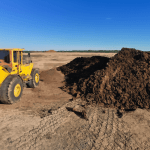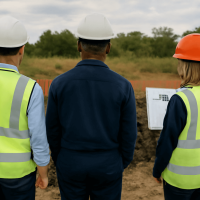Construction is the backbone of urban growth, driving new infrastructure, residential projects, and commercial developments. Yet, alongside this progress comes a pressing challenge: construction waste. From concrete and bricks to metals, wood, and hazardous materials, the byproducts of building projects can pose serious environmental and economic problems if not managed properly. This is where construction waste disposal becomes a vital element of responsible development.
In this article, we will explore the importance of construction waste disposal, its impact on the environment, sustainable practices, and how companies like Peel Resource Recovery provide effective waste management solutions.
Why Construction Waste Disposal Matters
The construction industry is one of the largest contributors to global waste. According to data from the U.S. Environmental Protection Agency (EPA), construction and demolition activities generate hundreds of millions of tons of debris each year. Without proper disposal, this waste ends up in landfills, increasing pollution, greenhouse gas emissions, and soil contamination.
Effective construction waste disposal is not only about reducing environmental harm; it is also about resource recovery. Many materials discarded at construction sites—such as concrete, asphalt, metals, and timber—can be recycled and reused in future projects. This reduces demand for virgin raw materials and minimizes the industry’s carbon footprint.
Types of Construction Waste
Construction projects generate diverse waste streams. Understanding these categories helps in designing efficient disposal strategies.
-
Concrete and Masonry Waste
Concrete, bricks, tiles, and asphalt are the most common byproducts. These materials are bulky but highly recyclable when processed correctly. -
Metals
Steel, aluminum, and copper from pipes, wires, and structural frameworks can be recovered and melted down for reuse. -
Wood
Lumber, plywood, and timber scraps can either be repurposed in new projects or processed into bioenergy. -
Plastics and Packaging
Plastic sheets, pipes, and packaging materials contribute significantly to construction debris. -
Hazardous Waste
Paints, solvents, asbestos, and chemical containers require specialized disposal methods to prevent environmental contamination. -
Gypsum and Drywall
Common in modern construction, drywall waste can be recycled into new gypsum products.
The Environmental Impact of Poor Disposal
When construction waste is not managed responsibly, the consequences are severe:
- Landfill Overload: Construction debris can take up valuable landfill space that could otherwise be reserved for non-recyclable waste.
- Pollution: Hazardous materials can leak into soil and waterways, threatening ecosystems and human health.
- Greenhouse Gas Emissions: Organic construction waste, such as wood, generates methane when decomposed in landfills.
- Loss of Resources: Failing to recycle construction materials increases demand for natural resources, accelerating deforestation, mining, and quarrying.
Best Practices for Construction Waste Disposal
To mitigate these impacts, construction companies must adopt best practices for waste management:
-
Waste Audits and Planning
Before a project begins, conduct a waste audit to estimate the types and volumes of waste expected. This ensures efficient planning for sorting, recycling, and disposal. -
On-Site Sorting
Separating waste materials directly at the construction site increases recycling efficiency. Dedicated bins for concrete, wood, metals, and hazardous waste make the process smoother. -
Partnering with Waste Management Specialists
Collaborating with professional waste management services like Peel Resource Recovery ensures compliance with regulations while maximizing recycling opportunities. -
Recycling and Reuse
Materials like concrete can be crushed into aggregates, wood can be reused in carpentry, and metals can be recycled for industrial use. -
Hazardous Waste Management
Specialized containers and certified disposal methods are essential to handle hazardous materials safely. -
Training and Awareness
Educating workers about proper waste management practices helps in reducing contamination and improving sorting accuracy.
Role of Recycling in Construction Waste Disposal
Recycling transforms what would otherwise be waste into valuable resources. For example:
- Recycled Concrete: Used as road base, backfill material, or in new concrete products.
- Reclaimed Wood: Converted into furniture, flooring, or biomass fuel.
- Recycled Metals: Reintroduced into manufacturing industries with minimal energy usage compared to mining.
- Plastics: Processed into piping, insulation, and new packaging materials.
By recycling, construction companies can significantly cut costs, reduce environmental damage, and promote circular economy practices.
Economic Benefits of Responsible Waste Disposal
Apart from environmental advantages, responsible waste management also brings financial rewards:
- Reduced Disposal Costs: Recycling lowers tipping fees at landfills.
- Revenue from Recyclables: Selling reclaimed materials such as metals or aggregates can generate income.
- Compliance and Avoidance of Penalties: Following regulations prevents fines and legal disputes.
- Enhanced Reputation: Sustainable practices improve corporate image, attracting clients who prioritize eco-friendly solutions.
Peel Resource Recovery: Your Partner in Construction Waste Disposal
At the heart of sustainable waste management in Australia is Peel Resource Recovery. Specializing in construction and demolition waste disposal, Peel Resource Recovery provides comprehensive services that help contractors, builders, and developers manage debris efficiently.
Their approach emphasizes recycling, resource recovery, and compliance with environmental standards. By choosing Peel Resource Recovery, clients gain access to advanced waste processing facilities, expert guidance, and reliable collection services. This makes it easier to achieve sustainability goals while keeping projects cost-effective and legally compliant.
Government Regulations and Global Standards
Construction waste management is not just a choice—it is a legal requirement in many regions. For instance, the EPA sets strict guidelines on how construction and demolition waste should be handled, emphasizing recycling and safe disposal. Governments worldwide are increasingly pushing for zero-waste targets, encouraging companies to adopt circular practices.
Adhering to these regulations not only prevents penalties but also contributes to broader environmental protection goals. Companies that align with these policies gain long-term advantages, from smoother project approvals to stronger public trust.
For more detailed information on environmental regulations, visit the official EPA Construction and Demolition Debris page.
Future of Construction Waste Disposal
The future of construction waste disposal is heading toward smarter, greener, and more innovative solutions:
- Digital Waste Tracking: Technology will allow construction companies to monitor waste streams in real-time.
- Eco-Friendly Building Materials: Increased use of recycled and biodegradable materials will reduce waste generation.
- Circular Economy Integration: The construction industry will shift from a “take-make-dispose” model to a system that prioritizes resource recovery.
- Government Incentives: More incentives and regulations will encourage companies to invest in sustainable waste practices.
Conclusion
Construction waste disposal is a critical aspect of sustainable development. Without responsible management, construction debris can harm the environment, increase costs, and deplete natural resources. Through effective practices such as on-site sorting, recycling, and partnering with experts like Peel Resource Recovery, the construction industry can minimize waste and maximize sustainability.
By embracing eco-friendly practices and complying with regulations, businesses not only protect the environment but also enhance their economic and social standing. As the world moves toward a greener future, construction waste disposal will remain a cornerstone of responsible building and development.







